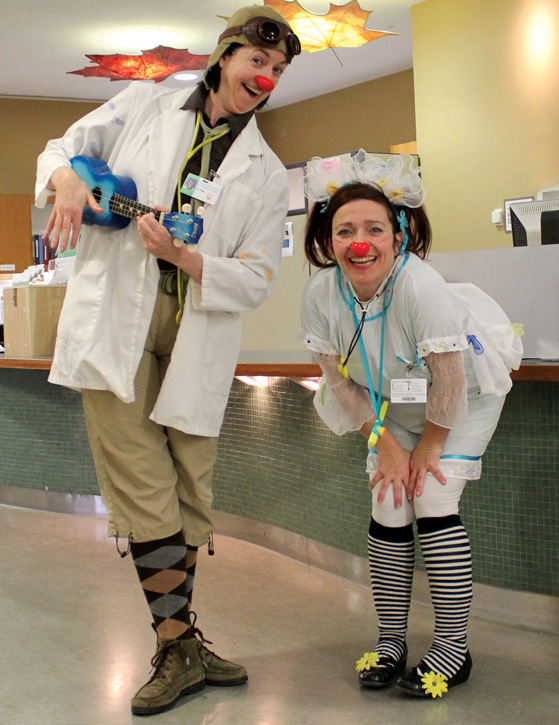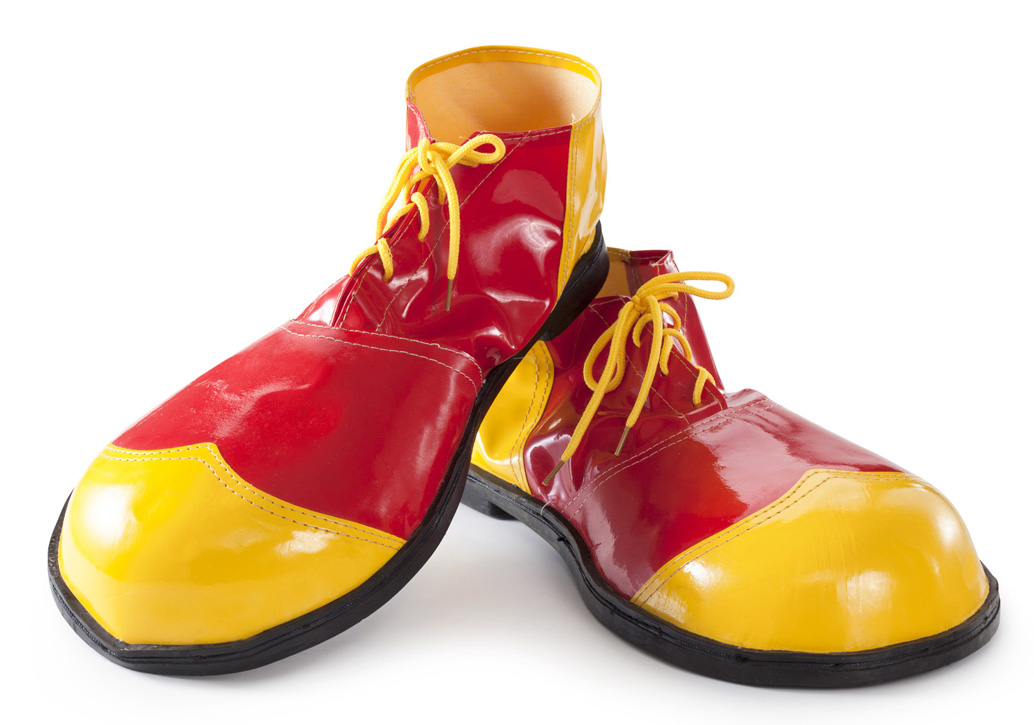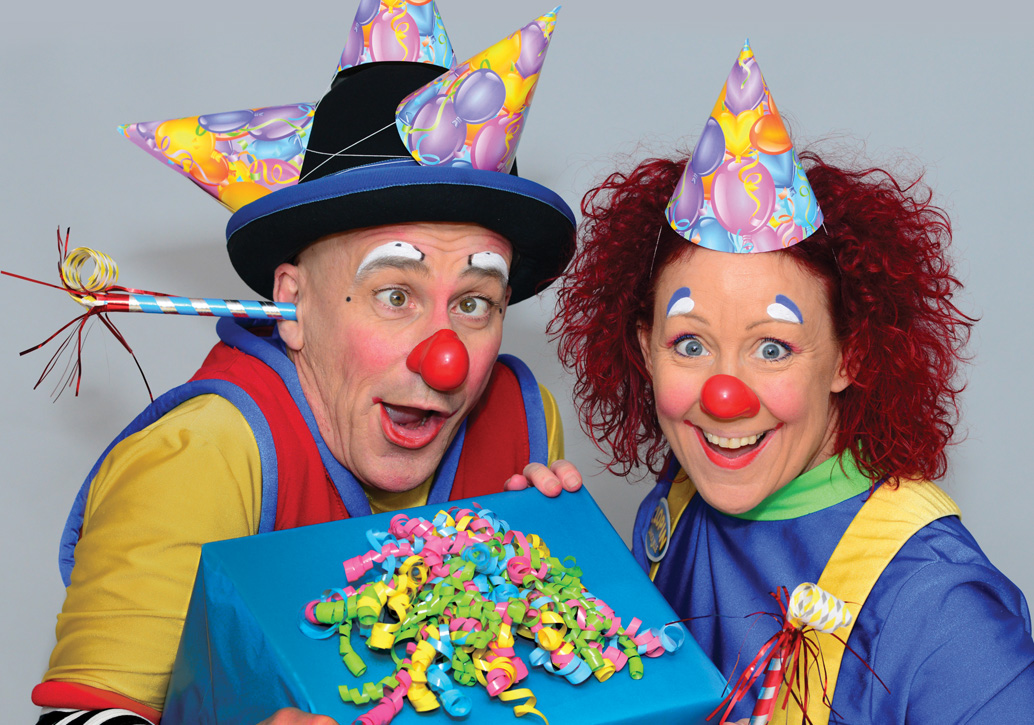A good clown is a mask that reveals
By Louise Kinross
Helen Donnelly is Holland Bloorview’s Dr. Flap—a therapeutic clown in a trademark aviator hat with goggles, a white medical coat and a red nose.
Her title is therapeutic clown, but she says “therapeutic clown practitioner” is more fitting. “Dr. Flap is the therapeutic clown,” she says. “The practitioner is the clinician under the nose.” Helen came to Holland Bloorview in 2007 to join Ricky, the clown that staff knew as Jamie Burnett, who has since passed away. This is how I described the pair in 2012: “No matter which room they were in, or whether the child could speak or move, the duo would create a kind of magic that bounced like a ball between the clowns and the child and the child and the clowns. Sometimes the magic moved back and forth through the blinks of the eyes alone, sometimes through silly body movements and sounds. Sometimes it was a child conducting the taps of drum brushes on a wheelchair tray or commanding the clowns to perform outlandish antics. Sometimes it was an elaborate story the child told and the clowns acted out. Other times it was a dance to the strums of a red ukulele.” In 2010, researchers here at Holland Bloorview published a study that showed that even children who can’t move or communicate verbally respond to our therapeutic clowns with changes in skin temperature, sweat level and heart and breathing rate.
 BLOOM interviewed Helen as she was about to do a 24 Hour Uke-A-Thon to raise funds for the hospital’s therapeutic clown program, which is completely funded through donations. In the photo above she appears (with ukulele) alongside Suzette Araujo, who is Nurse Flutter.
BLOOM interviewed Helen as she was about to do a 24 Hour Uke-A-Thon to raise funds for the hospital’s therapeutic clown program, which is completely funded through donations. In the photo above she appears (with ukulele) alongside Suzette Araujo, who is Nurse Flutter.
At SickKids I learned a lot about how to clown in the medical world. But the structure of being a clown working solo was challenging. I found working alone was emotionally and physically fatiguing and there wasn’t the kind of rigorous artistic support that I was used to. Then Jamie contacted me from Holland Bloorview and said he was looking for a partner. He wanted to mirror global best practices of having the duo model of clowning in hospital.
What are the benefits of two clowns together? Having worked both ways, there are so many benefits to the duo. There’s the emotional support. And having a partner who can constantly witness and feed back about the work ensures a greater degree of safety for clients and high artistic standards. Having two clowns means many more choices for the clients. And kids are smart and instinctively know what to do with two contrasting ‘fools!’
What’s a typical day like now? I work three days a week with Suzette Araujo, who is Nurse Flutter. Manuel Rodriguez, who is Nurse Polo, comes in if one of us is absent.
We check in, and we might go to inter-professional rounds or meet with child life specialists, in addition to looking up all of the clients we’re about to see on the electronic medical record. That helps us prioritize our client list. We spend one day a week on each unit from about 1:30 to 5 p.m.
We also collaborate with our fellow clinicians during a medical procedure or during therapy sessions. For instance, If there’s a wound change, which can take quite a while, we might employ physical comedy. We might get stuck inside the child’s bathroom and can’t find our way out, so we’re pleading at the door for the child to help us get out. It’s like visual candy, and it’s all housed in a comedic framework which can take us to some wonderfully dark places. It’s not always about frivolity.
There can be a lot of therapeutic merit in getting youth to release some of the darker feelings they might have. Because we’re artists, we have many skills in our back-pocket. We can make a rock opera out of their feelings. We’re musical by nature, and we’re skilled in the art of improvisation. We’re flexible and can go where they want to lead us, fearlessly and with joy.
 The great thing about clowns is we’re playful rule-breakers, we’re not beholden to society’s norms. Kids and teens instinctively understand what that looks like and how to use their clowns. It’s only when we become adults that we forget.
The great thing about clowns is we’re playful rule-breakers, we’re not beholden to society’s norms. Kids and teens instinctively understand what that looks like and how to use their clowns. It’s only when we become adults that we forget.
Are there other objectives? A philosophical aim is to seek out ways to change the atmosphere of the entire unit. So, how can we lift the spirits of our fellow clinicians and give them the kind of encouragement and praise that they always deserve? Good care trickles down, and if you look after the caregivers, it benefits everyone.
A very important part of our day is when we debrief and reflect on the interventions at the end of the day. The remaining half hour is documentation. We’re the only clowns in the world to electronically document every intervention in the permanent health care records of our clients. Lots of clowns document, but not electronically. The benefit is that clinicians can check in on our notes: ‘Oh, does Johnny like clowns? Oh, wow, it says he’s musical.’ So they’re learning aspects about their clients that they can use.
Who is Dr. Flap? Dr. Flap is a flight doctor from the fictitious island of Tubegosh, which is in the Atlantic, Pacific, Mediterranean area. Dr. Flap is regularly regarded as genderless, so often goes by the pronoun ‘they’ or ‘their.’
Why is that important? There’s a tradition among some indigenous cultures in which the fool in that society is gender-fluid. This is something that always appealed to me when it comes to offering choices to our audience. I can’t tell you how much joy we get every time a client decides Dr. Flap is male—and what a wonderful thing it is when the parent does not correct their child! In this way, the clown can symbolize fluidity in many things—that moods can change, a person’s health can change, our gender can change. Anything is possible.
Cool. What happens inside you when you put on your costume? We like to call them clown outfits or clown skins, because the clown is a huge aspect of our authentic self. Dr. Flap is a better or bigger version of Helen. This transformation inherently gives the clown artist a lot of energy and resiliency. As Helen, I am devastated to learn about some of the things that occur in this hospital. But as Dr. Flap, I’ve been able to withstand so much hardship and witness so much pain.
There’s something about the nose that keeps you focused on what’s really going on, and what you perceive is needed in the moment. It’s the least selfish you can ever be. It’s truly putting yourself in that ‘servant’s heart’ frame of mind. It frees you up from being in your head or in your worries. You find a lightness. It’s because you’re giving yourself permission to be in this lighter self that you can hone in on what’s needed in the moment.
What do you love about the work? It’s the opportunity to offer my art and all that I am in a system that I love, and one that is totally different than the one I perform in otherwise. I’ve always been around healthcare and I’m comfortable here. I was a kid in health care myself, and I was a candy striper in the ‘80s.
You were a patient? I was bitten by a dog when I was five and I had to have several surgeries to reconstruct my cheek. My hospital experience was amazing. I remember my doctor’s name and my roommate was 16. She was there for an appendix operation. There was a big doll house in our room and she and I would play doll house for hours. I got presents from my parents and friends.
Was the surgery painful? How long were you hospitalized? I don’t remember the pain from there. What I do remember is the aftermath—the reintegration back into school. I think it was a couple of weeks, and I had several surgeries over several years. But the emotional pain was so much worse. It took me a long time to heal, and I had to constantly wear bandages and put on special cream. Kids aren’t the most delicate of beings. So I was called a monster and I was the kid in the playground you’d feel sorry for—the one holding the teacher’s hand at recess because no one wanted to play with me.
My socialization was halted for a long time. I found it difficult to connect with people and make friends. Everyone stayed away from me. On the good side, I had a remarkably imaginative life and we lived in the country. So it was natural that I would connect to the fairies in the forest, and build whole worlds, and become different entities. That’s what led me to theatre.
You’re planning to start a therapeutic clown school. Can you tell us about that? It’s the opportunity to have my dreams realized, and to carry on Jamie’s legacy. That is a huge motivator for getting out of bed every day. When Jamie was declining, I promised him that I would continue to do two things: the first was to ensure that our program is secure and safe, and the second was to build a school for therapeutic clowns. Now, I’m building a certification for therapeutic clown that will be the first of its kind in North America. I’m building it through George Brown College, in partnership with Holland Bloorview. We need to have formalized training with proper supervision and evaluation.
How do you and your clown partner manage the emotions that come with the job? We take self-care extremely seriously. We’re the kidney of the hospital: filtering everyone else’s emotions, as well as our own, is the art of the clown. One of the benefits of the duo-ship is we dedicate time to sharing our feelings with each other. You have someone right there who’s witnessed the work. At the end of the day, we share how it felt and what we need from each other.
We make sure to give ourselves a break if we’ve had a difficult intervention. Six times a year, outside of clown hours, we meet with a psychotherapist for two-and-a-half hours of dedicated time, to talk about the effect of all of the filtering we do. We have to be healthy, happy, centred and grounded.
Do you have advice for other clinicians about the emotional side of the work? What’s helpful for me is to do practical things to help me refocus. I look at how I can be a servant in this time, instead of worrying about how it’s affecting me.
Instead of deflecting or diverting from what’s happening, it may be interesting to name it—express that you’ve noticed that something is going on with your client. If a client shares something that is absolutely sad or tragic, for us it would be disrespectful and untruthful to not let that affect us authentically. It’s important to them to see the effect of their news on their clowns. It builds trust, and we need to feel what they’re going through, to serve them well.
It reminds me of a narrative nursing group we did here, where the stories that staff shared unmasked their vulnerability, and how freeing that was.
A good clown is a mask that reveals, and instinctively, everyone knows that. If you’re truly willing to reveal yourself, it gives others permission to reveal themselves, to share where we’re at, what we’re feeling and what’s important.
You work with many children who are non-verbal and have very complex disabilities. What have you learned from them? The joy of connecting with them and meeting them where they’re at, and the joy of investigating inventive new ways to elicit a collaboration or a communication. I believe that our observational skills have skyrocketed because of them. Engaging with kids who communicate in alternative ways inherently demands a sensitivity and inventive approach that you otherwise wouldn’t adopt. It’s a much richer experience, and the techniques we adopt with the more complex kids are ones we use with verbal kids all the time. Things like mirroring or use of mime or contrasting pitch.
Have your thoughts about disability changed since you first came here? When I first came, like a lot of people who happen to be able-bodied, I couldn’t help but feel emotions like pity and sadness, and sometimes frustration. I’m not saying those things have been completely wiped out—that’s not true. I’m saying that I’ve grown to really appreciate how capable kids are of expressing their needs and moods and how much joy there is to be had just sharing our time together. Seeing how these children’s lives are being celebrated by everyone—not just by the parents or the clowns, but by all clinicians—and seeing the effect they have on everyone, it gives you hope that society can learn from how they live their days and what they choose to do.
In seeing how people change their way of thinking inside these walls, can we expect similar social change outside? We’re a kinder society in here. But the winds are changing and shifting and that gives me hope.
Louise Kinross is the editor of BLOOM, a Canadian blog on parenting kids with disabilities.
Reprinted with permission from Holland Bloorview Kids Rehabilitation Hospital.














